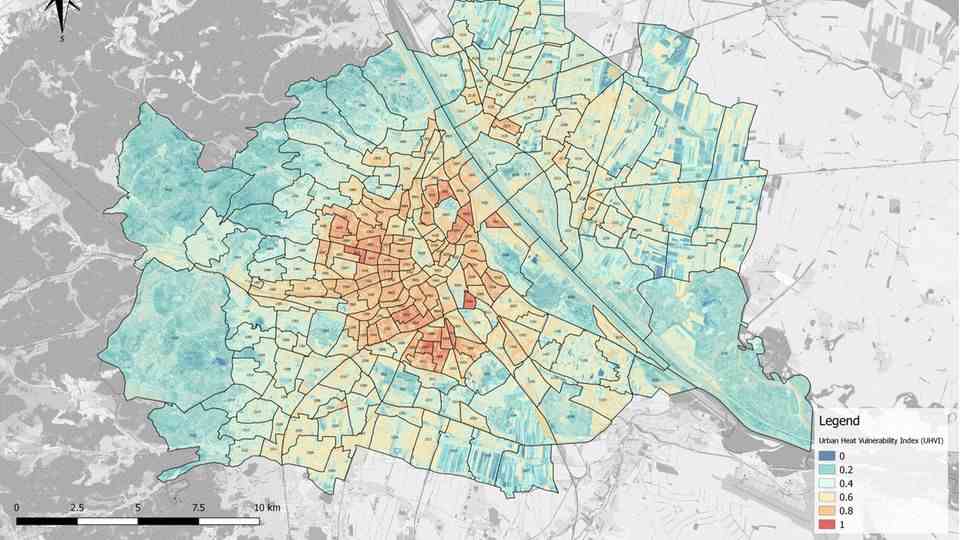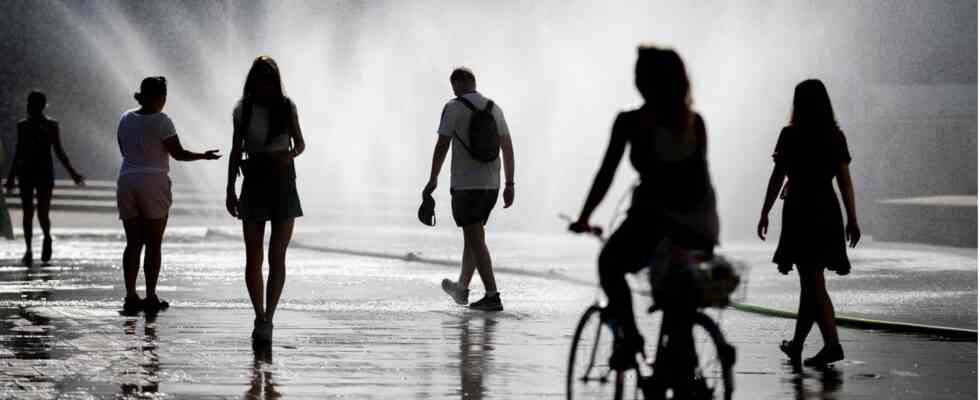It’s not just Madrid or Lisbon that are currently suffering from the heat. A city in the center of Europe recently broke its previous temperature record with almost 40 degrees. More could follow – but be prepared for that.
Vienna is best known for its Sachertorte and Schönbrunn Palace, Viennese charm and its coffee house culture. This year, the list has been expanded to include a purely practical item: 170 mist showers that are intended to provide refreshing freshness in public places and in pedestrian zones. Like so many cities in Europe, the Austrian capital is currently being hit by a heat wave. The mist showers are intended to reduce the temperatures a little, at least for a short time, and make it easier for passers-by to find their way through the pedestrian zones.
The city urgently needs this, because here, too, climate change is presenting itself at its highest temperatures. Depending on the scenario, the average annual temperature could rise between 1.2 and 1.5 degrees by 2050. Researchers at ETH Zurich even assume values of around seven degrees – a top value in Europe. What is certain so far is that at least the number of summer days has risen drastically since the mid-1990s. 83 were counted last year, of which the 30-degree mark was broken in just over a quarter. Weather experts then speak of hot days.
“Due to climate change, it can be expected that the climatological profile of cities will continue to change. In the year 2050, Vienna will have conditions that we find in cities much further south today. So there are still major challenges waiting for us in the future,” predicts Roman Hoffmann from the Austrian Institute for Demography of the Austrian Academy of Sciences (ÖAW).
Vienna is one of the heat leaders
In a 2019 study, an international team of researchers determined which European capitals would be most affected by heat waves. Vienna occupies one of the top places in the ranking. The scientists see the reason in the population density. The more people live together in a small space, the more ground is covered with asphalt for houses, apartment blocks and streets – in short: sealed. In Vienna, with a population of 1.9 million, 4,656 people live on one square kilometer. For comparison: In Rome there are 810 inhabitants per square kilometer.
According to the City of Vienna, the rise in temperature is noticeable in the form of heat islands. A heat map shows that the high temperatures are mainly concentrated in the asphalted inner-city area.

Most heat islands are located in the inner city area
© City of Vienna / Ecoten
Vienna’s mayor boasts that 53 percent of the city consists of green spaces. However, the city is expected to grow by around 60,000 citizens in the coming year. Living space is being created in the north for this purpose. This means that more areas have to be sealed – with potentially negative consequences for the health of the residents.
In the hot summer of 2018, that counted Health and Food Safety Agency (AGES) 550 deaths due to high temperatures, the year before there were 375. Since then the number has dropped, but the OeAW has calculated that a third of all heat deaths in Austria come from Vienna.
How Vienna wants to get the heat problem under control
In order to avoid worse things happening in the future, the city is not just relying on fog showers. In addition, 1300 drinking fountains were built. “Brunnhilde,” as the sources are called, is part of a heat action plan that Vienna’s mayor only presented in the spring. Appropriate measures are intended to prevent the city from overheating and to prepare it for “extreme cases”.
Around 25,000 new street trees are to be planted by 2025. With the help of information campaigns for citizens, city employees, medical staff and educational institutions, people should be made aware of climate change and learn how to behave in high temperatures. Air-conditioned vehicles are intended to facilitate transport, while cool spots and shady outdoor parking spaces make working and living at high temperatures easier.
In the strategy paper, the city also geared the measures to particularly affected groups such as older people, citizens in socially disadvantaged parts of the city and children.
The unsealing of the city also sounds commendable at first. How serious the plans are, however, is questionable. Most recently, Vienna’s mayor pushed through the construction of an expressway and had a protest action by climate activists dissolved.
In any case, most of the measures still have to be checked first to see whether they can be implemented. For this purpose, a so-called steering committee meets, which regularly evaluates the measures and adjusts the heat action plan accordingly every year.
Heat resistance does not protect against social inequality
Criticism of the project comes from the research facility Weatherpark. She specializes in urban climatology and advises the city government. “The city has launched many good initiatives. But on the whole a lot is happening too slowly. Vienna is still far from doing enough,” says Managing Director Simon Tschannett. He advocates more radical adaptation measures, such as “reclaiming the sealed areas for greening”. There is also a need for more training and motivation among staff. “Otherwise, during the next conversion, only the black asphalt will be unpacked and sealed from facade to facade, without taking the opportunity to convert large areas,” he tells the “Süddeutsche Zeitung”.
The landscape planning office Tilia and the mobility design company Con.sens judged similarly. The plans are ambitious, but far from sufficient. They fear social injustice. When streets are greened, it is rarely in parts of the city where low-income people live.
However, if socially disadvantaged districts also benefit from greening, rents could rise again. It is feared that wealthier citizens would then displace poorer people. In order to prevent social injustices caused by adaptation to climate change, the city would have to expand its financial budget.
Master plan for the city of the future?
So will it stay with side showers and public drinking fountains for the time being? That’s not the solution either, says water expert Roman Neunteufel from the University of Natural Resources and Life Sciences on the Austrian broadcaster ORF. “The cooling effect of water is of course undisputed. (…) But the effect of spray mist systems is only very small. You can’t cool the whole city with it.” Water consumption should also be considered. In order to cool down the first district alone with mist showers, the amount of water would come together that could supply a good 25 households.
In the long term it is more effective to plant trees. They evaporate between 50 and a few hundred liters of water per day. In addition, they also provide shade.
By this summer at the latest, one thing will be certain: Cities must adapt to climate change and develop appropriate strategies. Researchers never tire of emphasizing that the heat in cities can have negative consequences for health, but also for productivity. Vienna’s catalog of measures could well become a role model for other cities.
According to OeAW researcher Roman Hoffmann, there is no master plan for THE climate-neutral and heat-resistant city. “Direct comparisons between cities are difficult because populations have very different geographic, structural or infrastructural conditions to cope with heat, and their demographics can also differ significantly. But the issue of the impact of extreme temperatures is also important for other cities Relevance.”
Sources: City vienna, Climatological days of Vienna, Study: Ranking of European cities after heat waves, Austrian Academy of Sciences“Southgerman newspaper“, Vienna.at“The standard“, ORF


